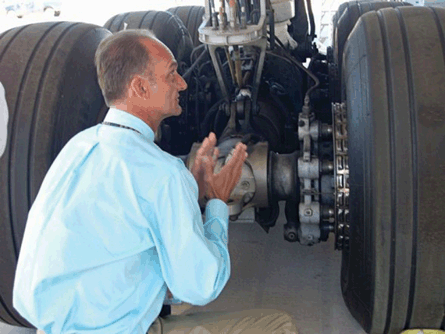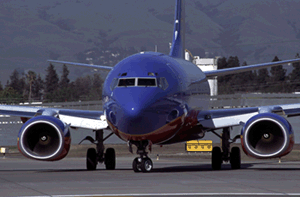Two years after an investigation into the blatant abuse of voluntary disclosure by the US Federal Aviation Administration and Southwest Airlines, the FAA has ushered in a philosophy change to dissolve any notion that airlines are the agency's customers.
Evidence supporting that new philosophy is most clear in the number of fines issued against carriers this year alone. The FAA has proposed a total of roughly $8 million in fines against American Airlines, American Eagle and Delta Air Lines. The carrier also aims to fine repair station GE Caledonian $1.2 million for performing improper maintenance procedures.
While some of the fines were borne out of violations that occurred several years ago and took time to adjudicate, the events of April 2008 and the new mindset of FAA Administrator Randy Babbitt have resulted in the agency creating new levels of accountability to eradicate the cozy relationships US legislators accused the FAA of having with carriers in the aftermath of Southwest operating 55,971 flights with 46 aircraft, without completing required checks for fuselage cracks.
 |
|---|
© PASS |
Inspectors overseeing the compliance of Southwest that allowed the carrier to improperly use the voluntary disclosure process to operate noncompliant aircraft "didn't do the job the way we want them to do the job", says FAA manager of flight standards certification and surveillance David Gilliom.
| US Airworthiness directives - Two years of unpredictability
FAA proposes a $10.2 million fine against Southwest for operating 46 of its Boeing 737s on 59,971 flights without checking the fuselages for cracks required under an airworthiness directive (AD) published in 2004. FAA orders US carriers to conduct in-depth audits of compliance with 10 ADs.
American Airlines grounds its MD-80 fleet and cancels roughly 3,000 flights after the FAA-mandated review of AD compliance shows the carrier's noncompliance with spacing of retention clips on certain bundles of wiring.
The Independent Review Team tasked by the Department of Transportation releases the results of its review of FAA oversight and its recommendations to change FAA culture, simplify AD compliance and improve the integrity of voluntary disclosure programmes.
Southwest settles the proposed $10.2 million fine by FAA to $7.5 million, after agreeing to make changes in safety related requirements. Southwest also hires a consultant to undertake a review of its regulatory compliance and its adherence to the Air Transport Oversight System.
Reports surface alleging Southwest of using unapproved parts on a number of aircraft. Eventually the carrier determines the parts were used on 82 aircraft, and FAA gives Southwest a December deadline to replace the parts.
FAA unveils a search for an individual to head its newly-created Office of Audit and Evaluation designed to handle whistleblower reports and passenger safety complaints.
FAA officially proposes a rule requiring a "cooling off" period before airlines, repair stations, flight schools and other certified entities could hire former FAA aviation safety inspectors that had any direct oversight of the certificate holder in the previous two years.
FAA confirms its inspection of another Southwest maintenance incident involving repairs to fuselage skins.
The Inspector General of the US Department of Transportation releases a review of the maintenance programme at American Airlines after a complaint that included 10 maintenance related allegations including a failure to follow procedures required for maintenance inspections.
FAA proposes two separate fines against American Airlines of $787,500 and $300,000 for maintenance violations after issuing two fines the month prior against American's wholly owned regional subsidiary American Eagle totalling roughly $5.4 million. The US Office of Special Counsel submits a report from the Inspector General to US President Barack Obama confirming a second set of allegations expressed by the original whistleblower that Southwest and the FAA inspectors overseeing its maintenance programme misused the voluntary reporting process after Southwest discovered it failed to comply with an AD involving window fasteners on 55 Boeing 737s. Southwest operated six uncompliant aircraft during a two-week period in 2007.
FAA's target to fully implement the National Air Carrier Evaluation Programme that independently reviews airline compliance. The teams are comprised of agency inspectors. The agency is currently reviewing compliance at two carriers.
FAA's target complete changes the AD compliance process after an aviation rulemaking committee completes its review of recommendations proposed by two teams to improve carrier compliance.
|
Any reference to airlines as customers has been removed from policy documents, says Gilliom, who adds: "It has been made clear," the relationship between the FAA and airlines is "not what a normal customer relationship might require".
Prior to Babbitt being sworn in as administrator in June 2009, the FAA operated largely under a "carrier friendly" scheme, says Professional Aviation Safety Specialists (PASS) vice-president Linda Goodrich. The message from the agency's executive level sent to mangers out in the field was to "do what makes them [airlines] happy. No doubt that translated into not interfering as much as possible." But with the events of two years ago, "that culture has radically changed," she says.
Another shift in oversight stemming from the lapse of inspections at Southwest is structural changes in how inspectors apply the air transportation oversight system (ATOS). Introduced almost 12 years ago, ATOS shifts how the FAA conducts oversight from purely using inspections to verify compliance with regulations to identifying risks within an airline's maintenance systems to stave off accidents or incidents before they occur.
But the transition to ATOS has been fraught with difficulties, with inspectors arguing managing the ATOS workload has resulted in dramatic cuts in time they spend in the field conducting hands-on inspections.
In June 2008 the US Department of Transportation's inspector general determined that missed ATOS inspections on numerous occasions resulted in compliance issues in the Southwest maintenance programme to go undetected for several years. At the time the carrier did disclose the missed fuselage inspections, the IG determined that the FAA had not completed 21 key inspections at Southwest in at least five years.
The weaknesses in ATOS and the workload pressure expressed by inspectors following the Southwest violations resulted in the FAA conducting a time-and-motion study of ATOS.
Goodrich of the PASS union says inspectors do have more authority to spend time in the field after the FAA's study showed that inspectors were spending roughly 15% to 20% of their time on administrative requirements of ATOS. As a result, "inspectors are being encouraged to get out and do more".
The FAA has a slightly different interpretation of ATOS results. "So much was said about inspectors not getting out in the field," says Gilliom. But the agency's ATOS study exposed some misperceptions in the rhetoric so that time in the field was compromised, he says.
However, after the Southwest episode heightened scrutiny over the workloads created by ATOS, Gilliom explains the FAA's study showed some redundancies existed in the system, and in June 2009 the agency completed its plan to streamline the process. Now he says roughly one-third fewer elements exist in inspector requirements to carry out ATOS.
DISCLOSURE
Initiatives are also under way to combat the abuse of voluntary disclosure exposed by Southwest and the inspectors overseeing its compliance. Gilliom says to prevent airlines operating noncompliant aircraft, both a principle inspector overseeing an airline and an office manager must sign off on a disclosure. Additionally, an individual with a higher level of authority at an airline must also acknowledge and sign-off on the disclosure.
But challenges remain in creating an environment where office inspectors feel comfortable reporting genuine safety concerns, warns Goodrich. The FAA has created the safety issues reporting system (SIRS) to allow inspectors to elevate safety concerns if the initial response from their supervisor is unsatisfactory.
Goodrich says that if an employee raises a concern beyond his or her immediate manager, the office is still investigated and the employee remains a target for contempt by supervisors. A significant number of inspectors are also concerned the issues raised through SIRS are being "closed out" in name only, she says. In her role at PASS, Goodrich visits roughly two FAA field offices per week, and "the feedback is that [SIRS] is useless".
Despite those concerns, the FAA and inspectors agree with taking a rational approach to compliance with airworthiness directives. A report published by an Independent Review Panel commissioned by former DoT Secretary Mary Peters states the grounding of American Airlines' MD-80 fleet during a three-day period in April 2008 "led many to suggest that the FAA over-reacted, and that the disruption to American's schedule was unnecessary".
After Southwest's noncompliance emerged, the FAA quickly ordered a nation-wide audit of carrier AD compliance. During those audits the FAA discovered discrepancies in the spacing ties on wire bundles in the landing gear bay of American's Boeing MD-80s.
Virtually all airline officials interviewed by the independent review team and many within the FAA "believe the agency's actions represented a substantial departure from business as usual, and that the agency used an uncommonly literal interpretation of the AD", said the panel in its final report.
Goodrich says that after those events "there was deep concern over did we take it too far?"
American adopted an alternative method of compliance (AMOC) for use in the AD that triggered the groundings. The FAA's former director of flight standards services and current aviation services advisor Jim Ballough explains the agency is working to "give inspectors the tools they need not to make decisions in a vacuum," regarding compliance and AMOC adoption.
With roughly 250 ADs issued annually, Ballough says the agency is also considering assigning a "category one" rating to more complex directives, with an accompanying compliance planning process put in place.
Yet even after the industry was forced into a top-down review of compliance, the airline that triggered the storm of controversy continues to face challenges. Since the events of 2008, Southwest last year discovered aircraft in its fleet operating with unapproved parts, and the FAA is investigating certain fuselage repairs made by a third-party for the carrier.
The FAA's Gilliom says a complete turnaround has occurred in upper management of the agency's Southwest region overseeing American and Southwest. But the person responsible for uncovering the unbalanced relationship between Southwest inspectors and the FAA, whistleblower Charalambe Boutris, has issued a warning to the US Office of Special Counsel about FAA management: "There is no accountability throughout the ranks."
Independent review team panel member William McCabe says: "You need absolute clarity and accountability, and it is hard for management to consistently achieve that."
A significant cultural element exists in all these issues, says McCabe. "Are you more enforcement oriented or collaborative oriented? Too much in either direction creates problems. That is why you need a strong manager."
 |
|---|
© Southwest AirlinesFAA had not completed 21 key inspections at Southwest Airlines in at least five years |
Source: Flight International























